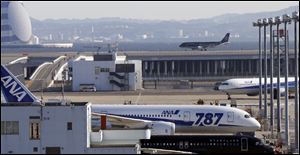
2nd battery in Boeing 787 fire checks out
'No obvious anomalies' found in plane parked in Boston
1/27/2013
A grounded All Nippon Airways' Boeing 787 is parked on the tarmac at Haneda airport in Tokyo. Although a fire destroyed one of two big batteries on a Boeing 787 parked at Logan Airport in Boston three weeks ago, a quick examination of the second battery found "no obvious anomalies," the National Transportation Safety Board said Sunday.
WASHINGTON — Although a fire destroyed one of two big batteries on a Boeing 787 parked at Logan Airport in Boston three weeks ago, a quick examination of the second battery found "no obvious anomalies," the National Transportation Safety Board said Sunday.
The second battery was of identical design but used for a different purpose than the first, the agency said. Its report added scattered details to what is known about the incident, one of two battery problems that led to the grounding of all 50 of the 787s in airline service.
The board said that its laboratory was continuing to study the destroyed battery, whose function was to start the auxiliary power unit, a small jet engine used mostly on the ground. The battery, which was not being charged or discharged, caught fire on Jan. 7 while the plane was empty.
The undamaged battery on which the board reported Sunday was a backup for cockpit instruments, located near the nose. The board has released photos of the damaged and undamaged batteries.
On Jan. 16, on a different 787 on a domestic flight in Japan, the main battery began belching smoke a few minutes after takeoff, forcing an emergency landing. Investigators have not said whether it was being charged at the time. The planes were grounded shortly afterward.
The batteries use a lithium-ion chemistry, which has been in use for many years in many applications but is new in airplanes. Investigators say the problem could be the batteries or with the associated electronics used to manage them.
The board said Sunday that at the time of the fire at Logan, the plane, which belonged to Japan Airlines, had completed 22 flights and 169 flight hours.
The board's update also said that investigators had completed a review of two systems associated with the auxiliary power unit, at two locations in Arizona, and found no problems.
The board said it had sent two additional investigators to Seattle, where the board was working with the Federal Aviation Administration to review work at Boeing. One investigator will work with a group reviewing Boeing's corrective actions, and the other will work on how the lithium-ion batteries were approved by the FAA.
The safety board is an advisory body with no regulatory authority — that belongs to the FAA — but it is in charge of safety investigations.